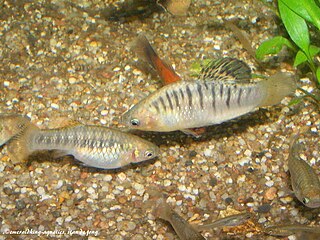
Poeciliidae are a family of freshwater ray-finned fishes of the order Cyprinodontiformes, the tooth-carps, and include well-known live-bearing aquarium fish, such as the guppy, molly, platy, and swordtail. The original distribution of the family was the Southeastern United States to north of Río de la Plata, Argentina, and Africa, including Madagascar. Due to release of aquarium specimens and the widespread use of species of the genera Poecilia and Gambusia for mosquito control, though, poeciliids can today be found in all tropical and subtropical areas of the world. In addition, Poecilia and Gambusia specimens have been identified in hot springs pools as far north as Banff, Alberta.

Poecilia is a genus of fishes in the family Poeciliidae of the order Cyprinodontiformes. These livebearers are native to fresh, brackish and salt water in the Americas, and some species in the genus are euryhaline. A few have adapted to living in waters that contain high levels of toxic hydrogen sulfide and a population of P. mexicana lives in caves.

Poecilia sphenops, called the Mexican molly or simply the molly, is a species of poeciliid fish from Central America. It was once understood as a widespread species with numerous local variants ranging from Mexico to Venezuela, but these variants are today considered distinct species belonging to the P. sphenops complex and P. sphenops itself as being native to Mexico, Guatemala, and Honduras. Due in part to its popularity as an aquarium fish, the species has been introduced outside of its native range, but many records may in fact refer to P. mexicana or other species from the complex. P. sphenops has been crossbred with other mollies, notably P. latipinna and P. velifera, to produce fancy mollies for the ornamental fish trade.

Lake Enriquillo is a hypersaline lake in the Dominican Republic located in the southwestern region of the country. Its waters are shared between the provinces of Bahoruco and Independencia, the latter of which borders Haiti. Lake Enriquillo is the largest lake in both the Dominican Republic and Hispaniola, as well as the entire Caribbean. It is also the lowest point for an island country.

Limia is a genus of livebearing fishes belonging to the Cyprinodontiform family Poeciliidae. It comprises 22 described species found in fresh, brackish, saltwater, and hypersaline habitats of the Greater Antilles islands in the Caribbean Sea. A vast majority are endemic to Hispaniola. There has been a long-running debate on whether Limia should be considered a subgenus of Poecilia rather than a full genus. Most Limia species are detrivores and herbivores. Due to their small size and coloring, they are sometimes kept in home aquaria.

The humpbacked limia or black-barred limia is a critically endangered species of poeciliid fish which is endemic to Haiti. Its common name is derived from the hump males develop as they age. It is sometimes kept in home aquaria.
Lake Miragoâne is a lake in Haiti, located one kilometer southeast of the city of Miragoâne. It is one of the largest natural freshwater lakes in the Caribbean. The lake is 12 km (7.5 mi) long and 25 km2 (9.7 sq mi) in area.

Perugia's limia is a poeciliid fish endemic to the Caribbean island of Hispaniola. It is one of the most widespread species in the Limia genus, inhabiting waters ranging from fresh to hypersaline. Unlike most Limia species, L. perugiae is omnivorous. Dominant males are especially colorful. Females give birth to live young.

Micropoecilia is a genus of poeciliids native to fresh and brackish water from the Amazon Basin to Trinidad. While recognized as valid by FishBase, others have considered this genus as being synonymous with Poecilia.
Gambusia dominicensis, known as the Dominican gambusia, domingo gambusia, or domingo mosquito fish, is a species of freshwater fish native to the lake of Etang Saumatre on Hispaniola, in eastern Haiti and the western Dominican Republic. A 2020 update to the IUCN Red List removed the Dominican Republic from the extent of occurrence description; the range map continues to include both countries. The authors noted, "Extent of Occurrence (EOO) and Area of Occupancy (AOO) cannot be determined with accuracy, as the species has not been collected since 1913 and georeferenced records associated with the type locality are lacking".

Heterandria formosa is a species of livebearing fish within the family Poeciliidae. This is the same family that includes familiar aquarium fishes such as guppies and mollies. Heterandria formosa is not as commonly kept in aquaria as these species. Despite the common name "least killifish", it belongs to the family Poeciliidae and not to one of the killifish families. H. formosa is one of the smallest fish species; the 1991 Baensch Aquarium Atlas listed it as the 7th smallest fish in the world, and as of 2006 it remains the smallest fish species found in North America.

The Hispaniola pupfish is a fish endemic to the lakes of Etang Saumâtre and Lake Enriquillo on the island of Hispaniola, in both Haiti and the Dominican Republic.

The Hispaniolan gambusia is a fish endemic to the island of Hispaniola.

Limia sulphurophila, also known as sulphur limia, is a livebearing fish in the family Poeciliidae. It is endemic to the Dominican Republic in the island of Hispaniola.

Limia islai, also known as the tiger limia, is a species of fish within the family Poeciliidae. This species is one of several Limia that are endemic to Lake Miragoâne, Haiti.

Limia melanogaster, the black-bellied or blue limia, is a poeciliid fish from Jamaica. It inhabits fast-flowing streams. It is a rare livebearer in modern fishkeeping.
Poecilia petenensis, the Petén molly, is a poeciliid fish species endemic to Guatemala.

Limia tridens, commonly known as the Tiburon limia, is a poeciliid fish endemic to the Caribbean island of Hispaniola.
Limia grossidens, also called the largetooth limia, is a critically endangered poeciliid fish endemic to Haiti.
Limia fuscomaculata, also called the blotched limia, is a critically endangered poeciliid fish endemic to Haiti.















